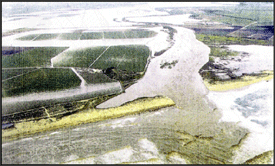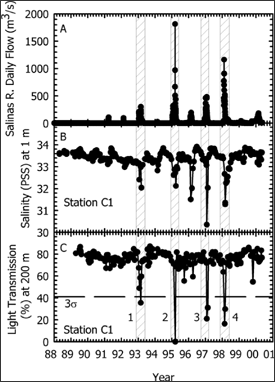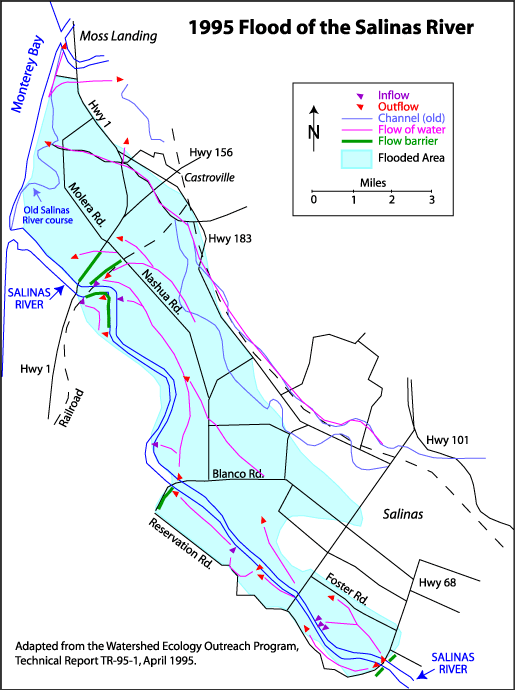
FACTS
- Storms during the 1995 El Niño winter caused extensive flooding along the central California coast.
- The Salinas River discharged 3 million tons of sediment per day.
- On March 12th, 1995, the largest flood in 100 years hit the central Monterey Bay area, affecting both the Salinas and Pajaro River systems.
- Flood waters flowed into low-lying areas that were part of the “wet corridor” before the river course was influenced by humans.
During January and March of 1995, intense rainfall (5-10 inches per month) hit the California coast, causing widespread flooding and destruction. More than 70% of the state’s counties were declared disaster areas, with an estimate $2 billion in damages. The storms of 1995 occurred during an El Niño phase, which generally causes higher than average rainfall and storm frequency in this part of California.

During the flood events, as much as 3 million tons of sediment came out of the Salinas River and traveled down the Monterey Canyon each day (Figure 1). According to a US Geological Survey report, discharge from the Eel River in northern California produced a 10 cm-thick layer of sediment on the continental shelf during the 1995 events.
Floods on the Pajaro and Salinas Rivers on March 12th were so severe that they cut off access to the Monterey Peninsula (Figure 2). The rivers overflowed and broke through containment dikes, allowing water to flow into low-lying areas that had once been natural channel beds and wetlands (the “wet corridor”; Figure 3). Because of the dikes, water that had overflowed was often unable to return to the main channel. Instead, flood water ponded behind barriers to flow, such as Highway 1 next to the Pajaro River, causing extensive structural damage.
Flood control design on both rivers was not sufficient to manage the amount of discharge from the March 1995 storms. The primary flaw was that the flood control channels were too narrow and confined. Furthermore, containment dikes were not designed with proper slope angles and vegetative cover to resist erosion. The channelization of rivers in populated areas is extremely common; it prevents the natural migration of the river channel and decreases the area covered by water, thereby reducing the amount of water that is able to recharge groundwater aquifers.
Fortunately, flooding patterns seen during the March 12th, 1995 event can be used to develop new flood control and water retention areas that can best benefit groundwater, water quality, wildlife habitat, and infrastructure protection.

Links to More Information
The California State University Monterey Bay Watershed Institute